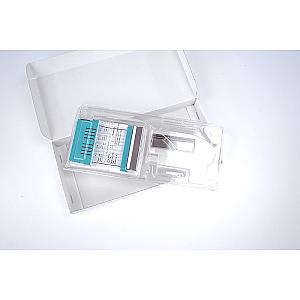The Thermo Scientific™ 24073290 dispensing cassette is a precision solution for dispensing small volumes of liquids, specially designed for Multidrop™ Combi and Combi+ dispensers . Featuring plastic tips with a fine orifice (0.22 mm) and a 0.5 mm diameter silicone tube, it delivers volumes ranging from 0.5 to 50 µL with remarkable reliability. Reusable up to 10 autoclave cycles, it is ideal for demanding applications in molecular biology, high-throughput screening and pharmaceutical research. Its compact design fits perfectly into automated laboratory systems.
Dispensing Cassette 24073290 - Perfect Condition





Offer Details
Accessories :
5771
Options :
NEW Thermo Scientific 24073290 Multidrop Combi Accessorie Dispensing Cassette
Description
24073290 Dispense Cassette: precision and reliability for low volumes
The Thermo Scientific™ 24073290 dispensing cassette is specifically designed to meet the needs of modern laboratories for low-volume liquid dispensing. It is part of the range of consumables compatible with Thermo Fisher Scientific's Multidrop™ Combi and Combi+ dispensers, renowned for their performance and versatility in the rapid and reproducible dispensing of reagents.
This cassette incorporates a 40 cm long silicone tubing system with an internal diameter of 0.5 mm, allowing for smooth and accurate fluid transfer. Its polypropylene tip with a fine orifice (0.22 mm) ensures accurate liquid dispensing while reducing the risk of cross-contamination. It is particularly suitable for applications such as compound screening, enzyme assays, cell assays and protocols requiring low dispensing volumes of 0.5 to 50 µL.
Its low dead volume (<1 mL) allows for economical use of expensive reagents, which is a major advantage in research environments where every microlitre counts. Although this cassette is not designed for unlimited use, it can withstand up to 10 autoclave cycles, ensuring controlled reuse without compromising hygiene and performance.
Its compact design and compatibility with automated systems make it suitable for use in robotic environments, particularly where space between the reagent container and the instrument is limited.
To maintain optimal performance, it is recommended that the cassette be cleaned daily after use. A simple rinse with deionised water (minimum 10 mL) removes any residue. In case of more significant contamination, mild detergent solutions such as Tween™, Triton™ X-100 or Micro-90™ at 1% can be used, followed by a thorough rinse.
This cassette is an ideal solution for researchers and laboratory technicians looking to automate and standardise the dispensing of small quantities of liquid with maximum precision. Thanks to its reliable and ergonomic design, the 24073290 helps improve the efficiency and reproducibility of experimental protocols while reducing human error.
Features
- Designed for the precise dispensing of small volumes of liquid (0.5–50 µL)
- Low dead volume to maximise the use of expensive reagents
- Small-bore plastic tips (0.22 mm) for fine and precise dispensing
- Silicone tubing for optimal flexibility and broad chemical compatibility
- Autoclavable up to 10 cycles for safe reuse
- Compatible with automated systems thanks to its compact design
- Suitable for Multidrop™ Combi and Combi+ dispensers
- Excellent reproducibility and dispensing uniformity
- Hygienic design with easy cleaning using deionised water
- Ideal for high-throughput screening applications, biochemical or cellular testing
Technical Details
- Instrument compatibility: Multidrop™ Combi+, Multidrop™ Combi
- Dispensing volume: 0.5 µL to 50 µL
- Dead volume: <1 mL
- Number of autoclaves: Up to 10 times
- Tube material: Silicone
- Internal tube diameter: 0.5 mm
- Tip material: Polypropylene (PP)
- Tip diameter: 0.22 mm
- Tube length: 40 cm
Compatible Accessories
- 24073291: Plastic tip dispensing cassette – Pack of 5
- 24070290: Tubing for standard dispensing cassette (not directly compatible, but useful for standard models)
- 24073293: Long cassette with plastic tip (200 cm) for automated environments with greater distances
- Compatible distributors: Multidrop™ Combi and Multidrop™ Combi+ from Thermo Scientific